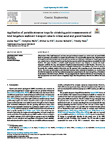OBSERVATIONS OF INFRAGRAVITY DOMINANCE IN THE SWASH ZONE OF A STEEP GRAVEL BEACH
| dc.contributor.author | BILLSON, O | |
| dc.contributor.author | Russell, Paul | |
| dc.contributor.author | Davidson, Mark | |
| dc.contributor.author | WIGGINS, M | |
| dc.contributor.author | McCARROLL, JAK | |
| dc.contributor.author | Poate, Tim | |
| dc.contributor.author | LEONARDI, N | |
| dc.date.accessioned | 2022-05-06T15:16:17Z | |
| dc.date.available | 2022-05-06T15:16:17Z | |
| dc.date.issued | 2019-05 | |
| dc.identifier.uri | http://hdl.handle.net/10026.1/19202 | |
| dc.description.abstract |
Observations of the depth integrated and time averaged sediment transport on a mixed sand and gravel (MSG) beach are presented and analysed to examine the performance of a new portable streamer trap. Measurement of the longshore sediment transport rate in the surf zone remains one of the great challenges in coastal engineering and coastal sciences. Sediment traps for sand beaches have proven useful in the past, but are not suitable for MSG beaches. This paper describes a portable depth-integrated streamer trap designed to measure the depthintegrated combined bed load and suspended longshore sediment transport on MSG beaches. The device consists of a polyester sieve cloth mounted into a rectangular holding frame. The stability of the device is achieved by gravity: the combined weight of the device and the operator, who is standing on and down-current of the device. The device has been tested in the field under moderate wave conditions at Minsmere, UK. We show that the observed suspended and bed load sediment transport are proportional to the wave energy flux, as formulated in the standard theoretical model, CSHORE. The data suggest that the empirical efficiency of wave breaking and bed load parameter are several orders of magnitude larger than that previously observed for uniform fine sand values. | |
| dc.format.extent | 1866-1878 | |
| dc.language.iso | en | |
| dc.publisher | WORLD SCIENTIFIC | |
| dc.title | OBSERVATIONS OF INFRAGRAVITY DOMINANCE IN THE SWASH ZONE OF A STEEP GRAVEL BEACH | |
| dc.type | conference | |
| plymouth.conference-name | International Conference on Coastal Sediments 2019 | |
| plymouth.publication-status | Published | |
| plymouth.journal | Coastal Sediments 2019 | |
| dc.identifier.doi | 10.1142/9789811204487_0161 | |
| plymouth.organisational-group | /Plymouth | |
| plymouth.organisational-group | /Plymouth/Admin Group - REF | |
| plymouth.organisational-group | /Plymouth/Admin Group - REF/REF Admin Group - FoSE | |
| plymouth.organisational-group | /Plymouth/Faculty of Science and Engineering | |
| plymouth.organisational-group | /Plymouth/Faculty of Science and Engineering/School of Biological and Marine Sciences | |
| plymouth.organisational-group | /Plymouth/REF 2021 Researchers by UoA | |
| plymouth.organisational-group | /Plymouth/REF 2021 Researchers by UoA/UoA07 Earth Systems and Environmental Sciences | |
| plymouth.organisational-group | /Plymouth/Research Groups | |
| plymouth.organisational-group | /Plymouth/Research Groups/Marine Institute | |
| plymouth.organisational-group | /Plymouth/Users by role | |
| plymouth.organisational-group | /Plymouth/Users by role/Academics | |
| dcterms.dateAccepted | 2021-01-01 | |
| dc.rights.embargodate | 2021-5-16 | |
| dc.rights.embargoperiod | Not known | |
| rioxxterms.versionofrecord | 10.1142/9789811204487_0161 | |
| rioxxterms.licenseref.uri | http://www.rioxx.net/licenses/all-rights-reserved | |
| rioxxterms.type | Conference Paper/Proceeding/Abstract |


